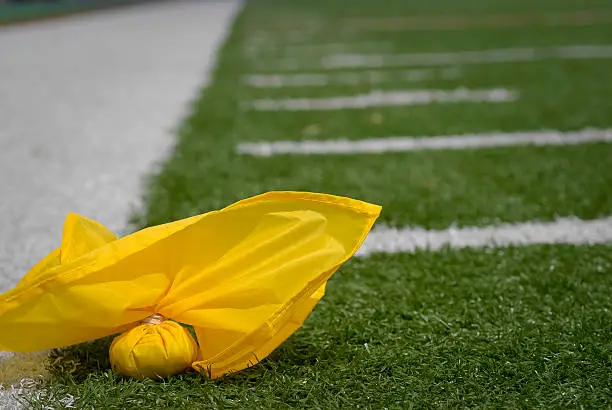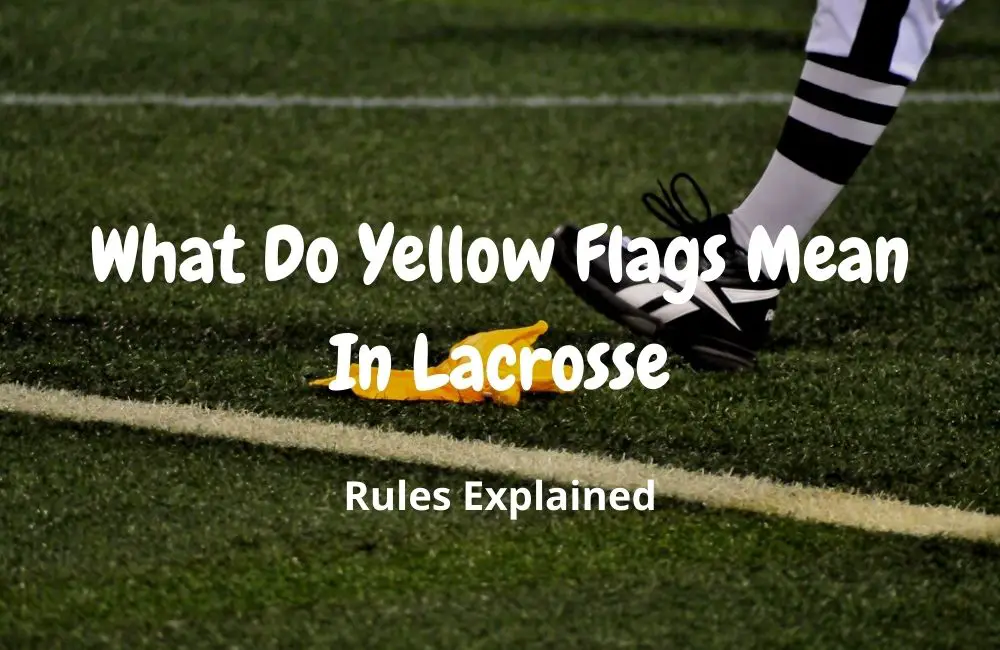If you are an avid lacrosse fan who watches collegiate or professional lacrosse, you probably have seen yellow flags before. The official throws the yellow flags onto the field while the game continues. This is a rather unique aspect to lacrosse experienced players and fans understand, but leaves casual fans scratching their heads. So what do yellow flags mean in lacrosse?
When you see officials throw a yellow flag, it means there’s a foul occurred. Then they will yell, “flag down”. However, the signal of the yellow flag doesn’t equate to pausing the game. The game often continues to progress until the referee blows the whistle.
Unlike a yellow card in soccer where it’s given after stopping the game, the yellow flag in lacrosse doesn’t stop the play immediately. And this is the part that confuses most beginners and casual fans.
For that reason, people have developed some misconceptions about what yellow flags indicate. Hence, as a member of the lacrosse community, I feel the responsibility to do a deep dive into yellow flags and clear out any confusion you might have.
Why yellow flags?
So now we know the yellow flag indicates there’s a foul that took place, but why couldn’t the referee just stop the play? It’s because this is a play-on scenario.

In simple terms, a play-on scenario refers to “letting the players play”. The referees don’t disrupt the game and continue to let the offense team progresses even though there’s a foul happened. This allows the offense team to play out the game without taking away a good opportunity for them to score. If a goal happens after the yellow flag was thrown onto the field, the score counts.
However depending on how severe the foul was, if it was under a moderate level, the score counts for the offense team and the game restarts with a faceoff. If it is considered a severe physical impact or ill-intended foul, the defensive player will serve time after the game restarts.
Hence, as you can see play-on scenario is a clever installment of the game. It incentivizes the defense to avoid fouling since the offense is able to continue the play and potentially lead to a score. Moreover, the defense can be hit with a double whammy – a lost goal and penalty time.
For this reason, this rule promotes a natural flow of a game without stifling the offense’s momentum and creating unnecessary pauses.
Watch this clip below to see how it works in a real game:
Does the yellow flag exist in women’s lacrosse?
In women’s games, there’s no yellow flag. Instead of letting the players continue, the referee immediately stops the game for every foul. This difference in rules has created controversies and discussion around whether women’s lacrosse should adopt the play-on scenario.
Based on what we understood about the play-on scenario in men’s lacrosse, there are two reasons why it will benefit women’s games. First, in the midst of intense ball action, the best thing to do is to let players carry out the progression and don’t interfere with the flow and momentum of the game.
Second, stopping the game drastically slows down the game’s pace. The public perception is women’s game feels slower than men’s game, and it’s exactly because of this rule difference. In a world of short attention spans, a lack of play-on scenarios makes the game feel disrupted. And that creates a barrier for people to completely engage with the game.
When does the game stop after a yellow flag?
Apart from scoring a goal, there are a few other ways to stop the game once the play-on scenario is underway.
They are:
- the shot clock is over
- the ball goes outside
- the defense regains possession
- an injury occurs
The idea is that the play-on scenario is an opportunity for the offense to continue that could potentially lead to a score. Once the opportunity is exhausted or completed, the referee will blow the whistle and indicate the play-on scenario is over.

First the referees decide if the foul warrants a penalty. Severe penalties include slashing, illegal body check, etc.) If so, they will then decide the penalty time and the format. Once that’s done, they will let the coach and the player know their final results. Often there will be some communications happen between the referees and the coach. But rarely the coaches can directly influence the referee’s judgment and decision.
As a result, the player will serve the penalty in the penalty box and their team goes man down.
Some misconceptions about the yellow flag
Unless you are an experienced player or long time lacrosse fan, it’s very easy to carry certain misconceptions and myths about the yellow flag. In this section, let’s demystify them one by one.
There can’t be multiple flags
It’s possible there will be multiple fouls committed in a very short window of time, which means it’s possible to see multiple yellow flags thrown onto the field. And a player can accumulate penalties during a play-on scenario.
Obviously, this could mean the player will serve longer time in the penalty box or worse, get disqualified for the rest of the game. Thus, even if a foul already took place, it doesn’t exempt the defense from further penalties. So if you see multiple flags on the field it indicates more than one foul has occurred.
There’s a designated area for officials to throw the flags
This is also false. There’s no certain place the officials have to throw the flags to. Typically the referee will throw the yellow flag in the defensive half as it’s easier for players to see. But again the referee can throw the flag anywhere onto the field.
This confusion stems from football where the penalty marker indicates where the foul occurred. So for football players, remember as long as you don’t hear a whistle, the game doesn’t stop.

Conclusion
After reading this post, you now have a much better grasp of what yellow flags mean. Most importantly, you know what to expect after seeing a yellow flag. If you haven’t encountered a yellow flag before, this could take a few games to get used to.
But simply remember the yellow flag doesn’t stop the game so long as you don’t hear a whistle. So be 100% focused on your current task whether it’s defense or offense. It’s, in fact, during times like play-on scenarios where scores happen or the defense team steals the ball and plays a comeback. Thus, it’s 100% in both teams’ interests to continue playing as well as they can during the play-on scenario.





